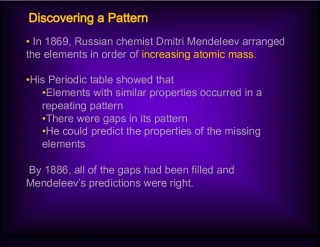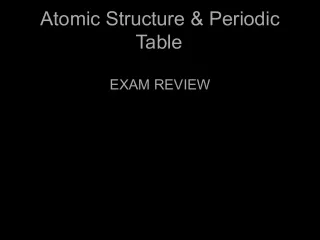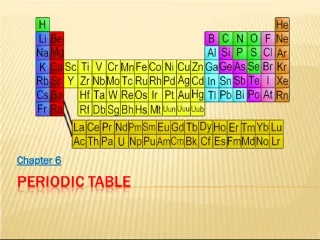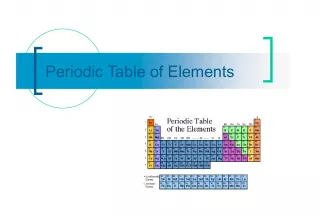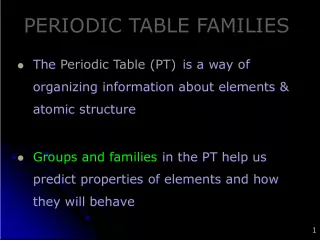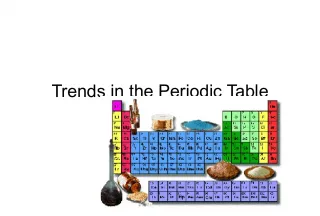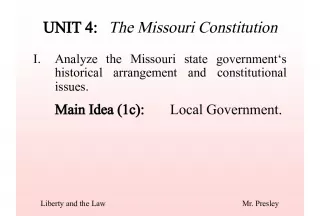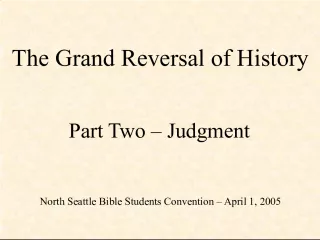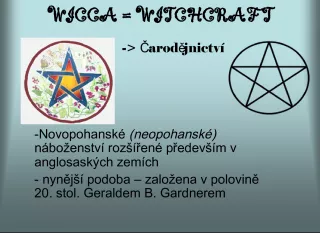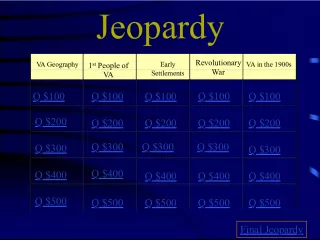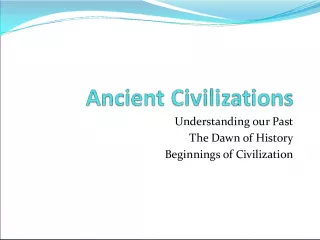The Periodic Table: A History and Arrangement


This article explores the history and organization of the periodic table, beginning with the work of Dmitri Mendeleev in the late 1800s. Mendeleev organized the
- Uploaded on | 2 Views
-
 caroline
caroline
About The Periodic Table: A History and Arrangement
PowerPoint presentation about 'The Periodic Table: A History and Arrangement'. This presentation describes the topic on This article explores the history and organization of the periodic table, beginning with the work of Dmitri Mendeleev in the late 1800s. Mendeleev organized the. The key topics included in this slideshow are . Download this presentation absolutely free.
Presentation Transcript
Slide1The Periodic TableJ. McLeod H. Chemistry
Slide3Essential Question How is the periodic table arranged?
Slide4A little history…Dmitri Mendeleev : 1 st Periodic Table organized the periodic table by increasing atomic mass Left empty spaces Predicted properties of unknown elements
Slide5Mendeleev’ s Table
Slide6A little more history...Henry Moseley : Modern Periodic Table (1887-1915) There were small problems with Mendeleev ’ s table. Used information he found about isotopes to modify Mendeleev ’ s table Determined that elements are put in order by their atomic number
Slide7Elements are arranged:Vertically into Groups/Families Horizontally Into Periods
Slide8Why?
Slide9If you looked at one atomof every element in a group you would see… Each atom has the same number of valence electrons Electrons in the outermost energy level (shell)
Slide10The group 2 atoms all have 2 electrons in their outer shells Be (Beryllium) Atom Mg (Magnesium) Atom
Slide11The number of outer or valence electrons in an atom effects the way an atom bonds. The way an atom bonds determines many properties of the element. This is why elements within a group usually have similar properties.
Slide12If you looked at an atom from eachelement in a period you would see… Each atom has the same number of energy levels.
Slide13The period 4 atoms each have 4 energy levels K (Potassium) Atom Fe (Iron) Atom Kr (Krypton) Atom 4 th Shell
Slide14Divisions of the TableThe Periodic Table is divided into regions based on general properties Include: Metals Non-metals Metalloids
Slide16Left side of the stairs Forms cations by losing electrons High Melting Points Solids at room temperature (except Hg) Metallic luster Malleable and ductile Good conductors of heat and electricity Metals
Slide17Non-metals Right side of the stairs Forms anions by gaining electrons Low Melting Points Gases or solids at room temperature (except Br 2 ) Brittle solids (Which means what?) Insulators (poor conductors or heat & electricity)
Slide18Metalloids Have properties of both metals and non-metals Semi-conductors Solids
Slide19Ticket Out The Door: State whether the following are metals, nonmetals, or metalloids and then predict a property that they may have: Potassium Iodine Antimony
Slide21Bellwork What are the vertical columns of the PT called? What do they have in common? What are the horizontal rows called? What do they have in common?
Slide22Groups
Slide23Hydrogen Belongs to a family of its own. Is a diatomic, reactive gas. Was involved in the explosion of the Hindenberg. Is promising as an alternative fuel source for automobiles
Slide24Group 1 Soft, silvery colored metals 1 valence e- Very reactive!!! Alkali Metals
Slide25Alkali Metal Video What trend in reactivity is seen amongst the alkali metals? What would you expect from Francium?!?!
Slide26Alkaline Earth Metals Group 2 Silvery-white metals 2 valence e - Fairly reactive Many are found in rocks in the earth ’ s crust
Slide27Transition Metals• Most are good conductors heat & electricity • Malleable (easily bent or hammered into wires or sheets)
Slide28How many things can you think of that have Transition Metals in them? Write as many down as you can in 1 minute.
Slide30Halogens Group 17 Have 7 Valence electrons Most are poisonous Cl 2 was used as a chemical weapon during WWI and WWII
Slide31Halogens What trend in reactivity is seen amongst the Halogens?
Slide32Noble Gases Group 18 8 Valence Electrons Very unreactive Gases at room temperature
Slide33Jellyfish lamps made with noblegases artist- Eric Ehlenberger
Slide34Lanthanide SeriesActinide Series Lanthanides & Actinides Located at the bottom of the Periodic Table Rare Earth Metals
Slide35Summing it up: Ticket out the DoorState which group each of the following elements belongs to and give a property of the element. Lithium Chlorine Uranium Krypton Strontium Chromium
Slide36Bellwork1. What is the most reactive metal? 2. What is the most reactive nonmetal? 3. How many energy levels does Strontium have? 4. How many valence electrons does Aluminum have?
Slide37Blank Periodic Table Write the names of the families in their respective columns Alkali Metals, Alkaline Earth Metals, Halogens, & Noble Gases Label the two rows with their respective names Lanthanides & Actinides Outline the metals in RED Outline the metalloids in GREEN Outline the non-metals in BLUE Draw an arrow showing reactivity of METALS Draw an arrow showing reactivity of NONMETALS
Slide38The properties of the elements on the periodic table create trends as you move around. Trends move left-right & up-down Periodicity
Slide39Reactivity of Metals Towards Francium Fr Inc. down a column Why? Increase in Size (value of n) Increase Shielding effect Inc. right to left across a period Why? Larger in size Weaker nuclear charge Decrease ionization energy
Slide40Inc. up a columnWhy? Decrease in size (value of n) Decrease Shielding effect Inc. left to right across a period Why? Smaller in size Stronger nuclear charge Increase ionization energy Reactivity of Nonmetals Towards Fluorine F
Slide41-½ the distance between two adjacent nuclei … increases as we go down a column WHY? add a new energy level each time … increases as we go right to left across a period WHY? Decrease in nuclear charge Atomic Radius
Slide42Atomic RadiiLi Na K Rb Cs Cl S P Si Al Br Se As Ge Ga I Te Sb Sn In Tl Pb Bi Mg Ca Sr Ba Be F O N C B 1.52 1.11 1.86 1.60 2.31 1.97 2.44 2.15 2.62 2.17 0.88 0.77 0.70 0.66 0.64 1.43 1.17 1.10 1.04 0.99 1.22 1.22 1.21 1.17 1.14 1.62 1.40 1.41 1.37 1.33 1.71 1.75 1.46 IA IIA IIIA IVA VA VIA VIIA = 1 Angstrom
Slide43ca t i o n s a n i o n s Ca atom Ca +2 ion Cl atom Cl -1 ion the size of an ion 20 p + 20 e – 20 p + 18 e – 17 p + 17 e – 17 p + 18 e – Ca Ca 2+ Cl Cl 1– cations lose electrons- smaller Anions gain electrons larger Ionic Radius
Slide44ia iia iiia IVA VA VIA VIIA0.60 0.31 0.95 0.65 1.33 0.99 1.48 1.13 1.69 1.35 1.71 1.40 1.36 0.50 1.84 1.81 0.62 1.98 1.85 0.81 2.21 2.16 0.95 Li 1+ Be 2+ Na 1+ Mg 2+ Cl 1- N 3- O 2- F 1- S 2- Se 2- Br 1- Te 2- I 1- Al 3+ Ga 3+ In 3+ Tl 3+ Ca 2+ K 1+ Sr 2+ Rb 1+ Cs 1+ Ba 2+ Li Na K Rb Cs Cl S P Si Al Br Se As Ge Ga I Te Sb Sn In Tl Pb Bi Mg Ca Sr Ba 1.52 1.11 1.86 1.60 2.31 1.97 2.44 2.15 2.62 2.17 0.88 0.77 0.70 0.66 0.64 1.43 1.17 1.10 1.04 0.99 1.22 1.22 1.21 1.17 1.14 1.62 1.40 1.41 1.37 1.33 1.71 1.75 1.46 Be B C N O F = 1 Angstrom Atomic Radii Ionic Radii Cations: smaller than parent atoms Anions: LARGER than parent atoms
Slide45– the energy required to remove an e– from an atom … increases as we go up a column WHY? shielding effect - increase in the number of energy levels … increases as we go from left to right across a period WHY? Nonmetals tend to gain electrons… high 1st ionization energy. Metals tend to lose electrons… low first ionization energy Ionization Energy Ionization Energy increases He
Slide46– the tendency for a bonded atom to attract electrons to itself … increases as we go up a column … increases as we go left to right across a period WHY? Nonmetals tend to gain electrons… high electronegativity Metals tend to lose electrons… low electronegativity Electronegativity electronegativity increases F
Slide47On the periodic table on the next page of your notes… draw out all of the trends if you have not done so already. Periodic Table
